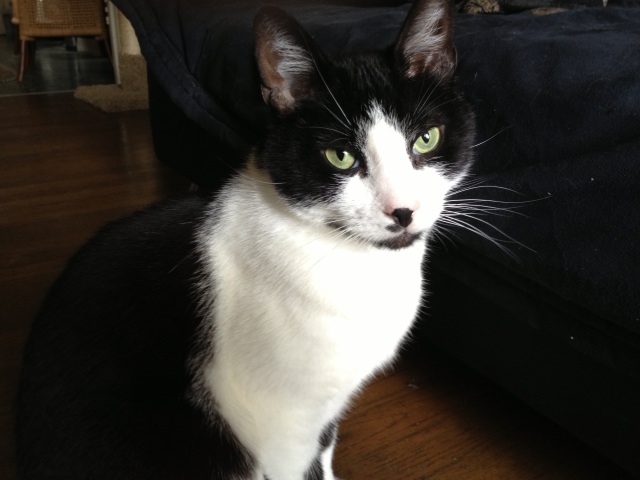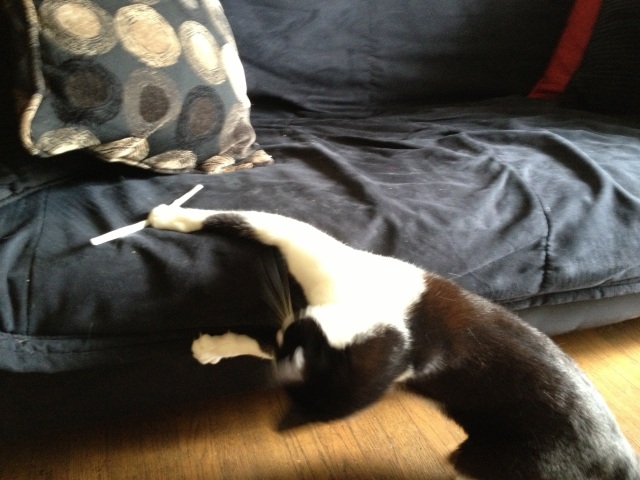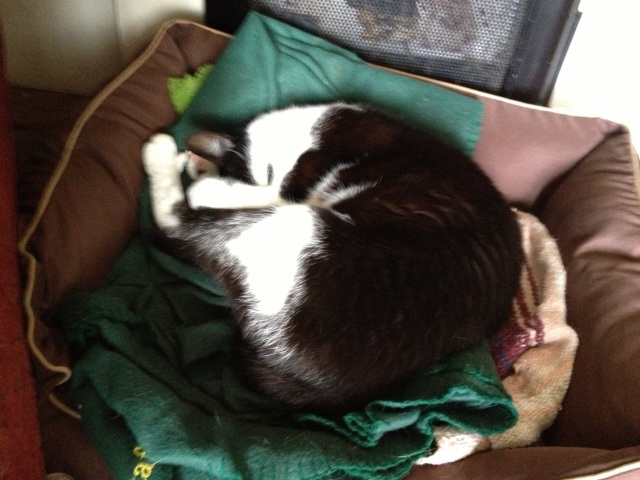I suppose I shouldn’t be so surprised, but my sabbatical studies in positive reinforcement have changed the way I relate with all animals, both human and other-than-human. That shift has become more obvious after these last 10 days I’ve spent with Jude the cat.
While I’ve been sticking around San Francisco this month, my good friend Lisa’s been fulfilling her yearly volunteer gig at a Girl Scout camp up in the Sierras. In exchange for a place to stay in the happening Mission district, I got the assignment of caring for her cat, Jude. He’s a handsome black and white beastie, strong in body and long in purr-sonality. He loves sitting on laps and he expresses affection with assertion, nudging his nose directly into lips for extended kitty kisses. And he’s super curious. Purr usual for me with cats, he offers a lot to like.
Before I arrived, though, Lisa had also offered some cautions. Jude is obsessed with food. Jude can insist on attention. Jude likes to bite when playing. Jude will wake you up every morning. Sure enough, several of those warnings played out even before Lisa had left, when I’d just come by the apartment for the first time. I watched him insert himself into the middle of our conversations and saw how he circled aggressively in the kitchen anytime one of us moved through that space. Crackers and grains, especially, seemed to grab his attention. Most times when Lisa picked him up to pet him, he’d eventually bite her hand or arm—not viciously or violently enough to really hurt, but enough to make me wonder for my future epidermal health. I hoped he and I would figure out some neutral ground between us, but I also acknowledged that it might be a long ten days.
At the same time, because of the studies in positive reinforcement I’ve done for my sabbatical—and with all my recent practice with our dog, Manny—I knew I could approach the challenge with a greater sense of calm. I started simply by watching Jude’s behavior without agenda, for example. I noticed that he liked being rubbed on the bones of his hips just above his tail. Whatever else he was doing beforehand, he’d stop and stay still for the attention. In contrast, I saw that if I petted his head or neck, he could only take two or three strokes before turning his head and opening his mouth as if moving to bite me. Duly noted, I thought to myself. We don’t need to pet his head and neck so much. I didn’t need to fight where he was. I needed to figure it out.
From there, I started noting what I reinforced. If I were to react strongly to any of his negative behaviors—giving him food off my plate to get him off the table, snapping sharply in response to his bite—I might accidentally accelerate that same behavior. Instead, I quietly shooed him off the table or removed him from my lap. Most crucially, I recognized that I needed to take care with his early-morning behavior. Sure, if I wanted to go back to sleep after he’d woken me up, I could most easily do that by getting up to feed him so he’d shut his little yapper. However, of course, that would only encourage him to do the same thing the next day. Rather than reinforcing his noise-making, I decided to wait until a lull in his insistence, when he had at least temporarily given up on getting my attention. Then, when he was quiet, I got up and fed him. And then went back to bed.
The clicker training crowd has taught me to be more systematic and experimental in pursuing desired behaviors, so I started putting that hat on as well. How else could I get Jude to stay quiet in the morning? I knew I couldn’t put out dry food overnight: Jude had gotten way overweight with free access to food in the past and, besides, his tendency to not drink enough water meant that dry food put too much stress on his kidneys and digestive system. Normally, Lisa would give him ¼ can in the morning to quiet him down and ¾ of a can of food just before going to bed, hoping that would tide him over for the long stretch of night, but I had shifted the percentages a bit so he wasn’t so bothersome during the day.
A few nights in, a new idea presented itself: What if I gave Jude “more” to eat by adding water to his food? Instead of putting his canned food on a plate, I doled it out into three cans and stirred each with warm water, creating a kind of cat-food slurry. I figured having to “drink” his dinner would both slow him down and put more in his belly to last through the night. Sure enough, Jude let me sleep in the next morning.
Since then, I’ve been using the method for all his meals. His one-can-per-day extends into more feedings and he now seems more mellow in between. He hasn’t been purr-fect in the mornings—he’s woken me up two or three times since—but he’s been lasting far longer. Moreover, we found an accidental side benefit: he’s getting plenty of water now.[1] I imagine the improved hydration affects his mood during the day as well. As I’ve been writing this, he’s stayed quietly curled up on his bed in front of the heater. No noodginess. Just a happy cat.
I don’t claim to have become a cat whisperer by any means. Jude still bares his teeth from time to time and he still expresses interest in being on the table when I’m eating. He showed little to no interest in the laser toy and bouncy balls I bought for him, preferring instead to stick with the chewed-up straw he likes to chase around the apartment. But we’ve been figuring it out together. Given this chance to take stock of my sabbatical studies, I like the way that positive reinforcement has changed my mindset. I’m calmer in assessing a situation. I notice more of how I’m contributing to the problem and its solution. And I’m more eager to experiment.
Hey, Jude. Problems are morphing into opportunities. We must be doing all right.
[1] Good news for Lisa: Jude’s drinking water! Bad news for Lisa: Jude’s going through his super-expensive World’s Best Cat Litter at a greatly accelerated rate. I’ll have to clue her in to the amazing benefits of using chick starter feed instead. Are you talking about food for baby chickens as cat litter? Yup. It’s non-toxic (if you get unmedicated), super absorbent, clumping, flushable, odor-killing, largely dust free…and about one third the cost of premium litters made of basically the same stuff. If you’re a cat owner with access to a farm supply store, this tip will revolutionize your life.




Purr!
🙂